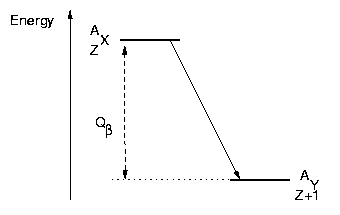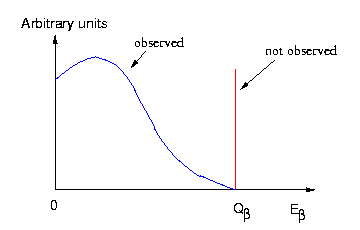
Physics goals - Neutrinos
|
|
|
|
|
|
|
The neutrino
Neutrino has first been invented by Wolfgang Pauli in 1930 to explain the observed continuous energy spectrum of electrons emitted in nuclear beta decay (figure 6). Enrico Fermi formulated a theory of the β decay process (beta is the historical name of the electron; for the electron and positron we use respectively β- and β+).

|

|
The maximum energy available in the β decay (Qβ) is called the Q value (figure 7). It is always a positive quantity otherwise the decay process is forbidden by the energy conservation law.

|
The three outgoing particles (daughter nucleus, electron and the anti-neutrino) share this energy, carrying a given amount of impulsion that makes them ejected from the primary position of the decaying nucleus. Practicaly, the daugther nucleus carry almost no energy due to kinematic effects of its large mass (relatively to both leptons masses). The emitted electron can be observed experimentaly and its energy can be measured; its energy ranges from 0 (electron at rest) to the maximum energy value available in the β-decay: Qβ (a.k.a. the end point of the energy spectrum, figure 8).

|
Detecting neutrinos
The electronic neutrino has only been experimentaly detected in the 1956 by Frederick Reines and Clyde Cowan near the Savannah River nuclear reactor. Their detector consisted in two tanks of water (H2O) placed near the nuclear reactor. Neutrinos coming from the nuclear reactor interact with protons of water through an inverse beta decay process:

|
The problem with neutrinos is the following: neutrinos only interact with matter through weak interaction processes, it means that the probability to obtain a neutrino capture by a target nucleus is extremely low. A 1 MeV electron is stopped in water after a few millimeter (electromagnetic processes) while lightyears are needed for a neutrino! To accumulate and study a significative amount of neutrino events, a neutrino experiment needs a very large detectors running for many years.
Are neutrinos massive?
Half a century after the Reines and Cowan experiment, we know three different kinds (flavors) of neutrinos but we still don't know much more about their fundamental properties than we did seventy years ago!
According to the (minimal) standard model of elementary particles, we think that neutrinos have no electrical charge nor mass. The assumption of massless neutrinos is not satisfactory on a theoretical point of view. The standard model cannot explain/predict the mass of elementary particles, then we cannot give any good reason why neutrino should have a zero mass while the other leptons (e-, μ-...) are massive (a good reason for a theoricist means a fundamental symmetry).
Years ago, HEP physicists had the idea that neutrinos should have non zero mass - like electrons, muons and taus - but this mass could be so tiny that we were not able to measure it until now!
Up to 2000, no experimental proof of the non-zero mass of the neutrino exists and we only know upper limits for the mass of each neutrino flavor (table 3).
|
Yes, they are!
At the very beginning of this 21th century, a new generation of experiments involving huge underground neutrino detectors (SNO, SuperKamiokaNDE...) have concluded after a few years of data taking that neutrinos of one flavor can change spontaneously into neutrino of another flavor: such a process is known as neutrino oscillations (figure 9 [preliminary]). It is made possible only if some neutrinos have non zero masses! This is a major breakthrough for HE physics. Nevertheless these measurements do not give us access to the absolute neutrino mass scale. We then still lack an experimental test to determine this value!
 |
Open questions
There is another question of great interest about the neutrino. As we can see in table 1, neutrinos have no electrical charge. The SM postulates that neutrinos are Dirac particle, i.e. the neutrino is different from the anti-neutrino. But theoricists had the idea (idea means that one can write valid equations!) that the neutrino and the anti-neutrino could be the same particle at a very fundamental level: we say it is a Majorana neutrino. Up to now, no experimental test to determine the matter/anti-matter symmetry properties of the neutrino was successful.
After 70 years of theoretical and experimental investigations, neutrinos are still very mysterious objects, despite of their relative simplicity in the current theory (SM). This very slow progression of knowledge is due to the fact that neutrinos are only sensitive to weak interaction processes; as a consequence they interact poorly (almost never) with matter; that makes their experimental study very difficult even with the huge detectors physicists use nowaydays.
Physicists still have the hope to do a better experimental work with neutrinos in the future. They plane to build some very, very huge detectors in conjonction with very intense neutrino beams (ν-factories). Another way to investigate new neutrino physics is to search for processes that are forbidden in the SM framework but could exist for example if neutrinos are massive Majorana particles. This is the aim of double-beta decay physics (see next section).
Contents
|
Last update: 30-03-2004